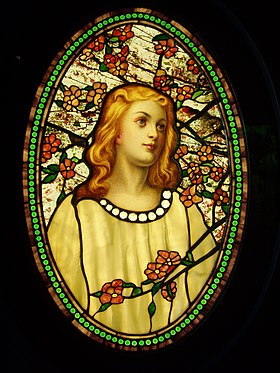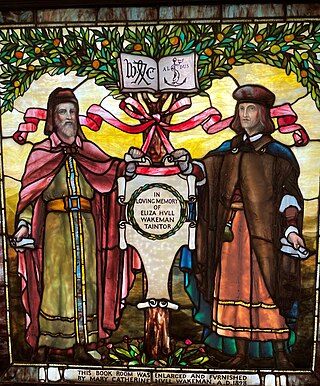

Tiffany glass refers to the many and varied types of glass developed and produced from 1878 to 1929–1930[1][2][3][4] at the Tiffany Studios in New York City, by Louis Comfort Tiffany and a team of other designers, including Clara Driscoll,[5][6] Agnes F. Northrop,[7] and Frederick Wilson.
In 1865, Tiffany traveled to Europe, and in London he visited the Victoria and Albert Museum, whose extensive collection of Roman and Syrian glass made a deep impression on him. He admired the coloration of medieval glass and was convinced that the quality of contemporary glass could be improved upon because the production of art glass in America during this time was not close to what Europeans were creating. In his own words, the "Rich tones are due in part to the use of pot metal full of impurities, and in part to the uneven thickness of the glass, but still more because the glass maker of that day abstained from the use of paint".
Tiffany was an interior designer, and in 1878 his interest turned toward the creation of stained glass, when he opened his own studio and glass foundry because he was unable to find the types of glass that he desired in interior decoration. His inventiveness both as a designer of windows and as a producer of the material with which to create them was to become renowned.[8] Tiffany wanted the glass itself to transmit texture and rich colors and he developed a type of glass he called "Favrile".
- ^ Cite error: The named reference
Tiffany Studioswas invoked but never defined (see the help page). - ^ Cite error: The named reference
Brooklyn Eagle - Polachekwas invoked but never defined (see the help page). - ^ Cite error: The named reference
Tiffany Morse Museumwas invoked but never defined (see the help page). - ^ Cite error: The named reference
NYT Bronze buys Tiffany Studios: again in controlwas invoked but never defined (see the help page). - ^ Taylor, Kate (February 13, 2007). "Tiffany's Secret Is Over". New York Sun. Retrieved 2009-11-16.
- ^ Kastner, Jeffrey (February 25, 2007). "Out of Tiffany's Shadow, a Woman of Light". The New York Times. Retrieved 2009-11-16.
- ^ McGreevy, Nora, Stunning Tiffany Stained Glass Debuts After 100 Years of Obscurity, Smithsonian Magazine, May 28, 2021
- ^ Lee, Lawrence; Seddon, George; Stephens, Francis (1976). Stained Glass. Spring Books. ISBN 0-600-56281-6.